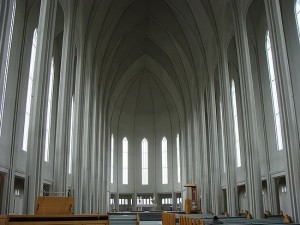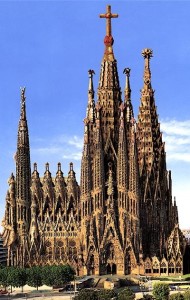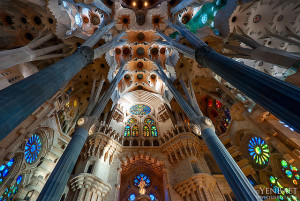This paradigm shift considers the use and ubiquity of images, that is, paintings, statues, stained glass, architecture, and art that depict saints and stories from the Bible.
Protestants view the use of images in prayer, liturgy, and religious ceremony as idolatry—a sin prohibited in both the Old and New Testaments, particularly the ten commandments which prohibit the use of “graven images” and bowing down to them in worship. However, for some reason, Protestants do not object to Nativity Scenes.
It’s no secret that the Catholic Church have always used icons, statues, and the like for devotional and religious purposes. Indeed, it’s standard practice to have statues of Mary or some saint at which people will kneel in prayer or light candles. Obviously, the Catholic Church misunderstood or ignored God’s enduring commandment on this issue. Right?
Analysis
First, let’s face it, Catholic church buildings are way more beautiful than the typical evangelical Bible Church. Catholic sacred places, particularly the cathedrals and abbeys of European antiquity, are designed to draw our spirits out and upward through depictions of the Divine through physical art forms—and why not? Art (the temple Curtain, tapestry, the Ark of the Covenant, Menorah), architecture (the Temple in Jerusalem) and music (The Psalms) were always part of religious expression and likely the reason God gave us these things—for worship and for beauty among general purposes.
But what about the first commandment? In Exodus 20:4 we read
“You shall not make for yourself a graven image, or any likeness of anything that is in heaven above, or that is in the earth beneath, or that is in the water under the earth; you shall not bow down to them or serve them; for I the LORD your God am a jealous God, visiting the iniquity of the fathers upon the children to the third and the fourth generation of those who hate me, but showing mercy to thousands of those who love me and keep my commandments.”
Regarding this first commandment it is important when understanding scripture that we understand the context, language, intent, culture, and all aspects from which the writing originated—-otherwise we will interpret scripture through the lens of our own times, culture, and politics and end up with what we want to believe. So what about the Exodus of Israel and the Ten Commandments?
The Israelites from Egypt were polytheists and needed this first commandment in a big way. They were not the devout Jews of the first century by a long shot, but were familiar with the pagan deities of Egypt and Canaan. Although they had the God of their fathers (Abraham, Isaac and Jacob), they had others they worshipped and adored. Did not Rachel grab the household gods in Laban’s tent? Did not Joseph practice divination? Did it not take centuries to wash out the polytheistic habits of Israel—Molech and Asherath poles in use up to the Babylon captivity? This was the mindset of antiquity, not the mindset of modernity. In the ancient world it was the practice to create an image of the gods you already worshipped. The first commandment addresses this outright for a people who were to be set apart from the other nations, for, it was routine in ancient times to appease all would be gods just so that things (agriculture, wars, health) would go good for you.
But did this forbid the creation of images for the purposes of right worship and praise? If so, how is it that the tabernacle and temple were infested with images? The Ark of the Covenant had Cherubim on it; the Temple had images of cherubim, pomegranates and created things. Solomon’s temple had impressive figures of twelve oxen—scandalous, given the old Egyptian penchant for cattle worship. In Exodus 25 and 1 Kings 6:23 there is no prohibition against statues and images that are not regarded as idols of worship since they built many into the Temple that God made His dwelling and filled with His glory. And what about Moses erecting the image of a snake in the wilderness? Was this idolatry? Not at first, but when in latter centuries Israel started to actually worship what the image represented in the form of a pagan god, the snake was cut down by Hezekiah (2 Kings 18). Images and statues are not the problem per se.
Let’s take this a step further. In contemporary evangelical Bible churches we are brought into worship with elaborate music productions, slideshow transitions, and stage lighting—some very expensive and lavish. Is this wrong too? Do I worship the emanations of sound and light or are they simply vectors toward the worship of God? Like music and lighting, physical objects divert our attention away from the noise of the world and into the presence of God. I don’t know about you, but I find it a useful and conducive mechanism, especially if you live in the hectic DC area.
Finally, Catholics don’t bow down and worship images of the saints nor do they worship the saints (including Mary) in any instance—that’s a total misunderstanding. Prayers to the saints for intercession are considered no different than you asking me to pray for you or for some issue. By asking me (the Church Militant) to pray on your behalf, are you worshipping me? Of course not. Then why is it a problem to ask the saints that stand in the presence of God (the Church Triumphant) for intercession? And you may notice that prayers to the saints are prayers for intercession, not words of worship and adoration.
Corollary: Iconoclasm
Iconoclasm is the destruction of religious images—priceless works of art and antiquities in the name of a religious cause. ISIS is the modern version of this, destroying ancient artifacts including a 1400-year-old monastery in Iraq this week alone. How tragic!
But the Protestant Reformation also involved iconoclasm in the 16th century, destroying what was the patrimony of every Christian then and now: monasteries, statues, bas-reliefs, and other works of art defaced or destroyed by the Reformers. This included King Henry VIII Dissolution of Monasteries where abbeys and their artifacts were destroyed including the loss of whole libraries of books, musical scores, and the knowledge therein. Can you image the destruction of Michelangelo’s David or Pieta or the ruin of the Duomo in Florence? Thank goodness we can enjoy those things today since Italy managed to stay out of the Reformation and its teachings.
Appendix: Church teaching on images and art. It is rather profound.
Here are a few of the teachings from the CCC on the use of sacred images and icons.
1159 The sacred image, the liturgical icon, principally represents Christ. It cannot represent the invisible and incomprehensible God, but the incarnation of the Son of God has ushered in a new “economy” of images: Previously God, who has neither a body nor a face, absolutely could not be represented by an image. But now that he has made himself visible in the flesh and has lived with men, I can make an image of what I have seen of God… and contemplate the glory of the Lord, his face unveiled.
1160 Christian iconography expresses in images the same Gospel message that Scripture communicates by words. Image and word illuminate each other: We declare that we preserve intact all the written and unwritten traditions of the Church which have been entrusted to us. One of these traditions consists in the production of representational artwork, which accords with the history of the preaching of the Gospel. For it confirms that the incarnation of the Word of God was real and not imaginary, and to our benefit as well, for realities that illustrate each other undoubtedly reflect each other’s meaning.
1161 All the signs in the liturgical celebrations are related to Christ: as are sacred images of the holy Mother of God and of the saints as well. They truly signify Christ, who is glorified in them. They make manifest the “cloud of witnesses”29 who continue to participate in the salvation of the world and to whom we are united, above all in sacramental celebrations. Through their icons, it is man “in the image of God,” finally transfigured “into his likeness,”30 who is revealed to our faith. So too are the angels, who also are recapitulated in Christ: Following the divinely inspired teaching of our holy Fathers and the tradition of the Catholic Church (for we know that this tradition comes from the Holy Spirit who dwells in her) we rightly define with full certainty and correctness that, like the figure of the precious and life-giving cross, venerable and holy images of our Lord and God and Savior, Jesus Christ, our inviolate Lady, the holy Mother of God, and the venerated angels, all the saints and the just, whether painted or made of mosaic or another suitable material, are to be exhibited in the holy churches of God, on sacred vessels and vestments, walls and panels, in houses and on streets.31
1162 “The beauty of the images moves me to contemplation, as a meadow delights the eyes and subtly infuses the soul with the glory of God.”32 Similarly, the contemplation of sacred icons, united with meditation on the Word of God and the singing of liturgical hymns, enters into the harmony of the signs of celebration so that the mystery celebrated is imprinted in the heart’s memory and is then expressed in the new life of the faithful. (2502)
Comparison
Compare the Lutheran Hallgrímskirkja church in Reykjavik started in 1945 (completed in 1986) with the Catholic Sagrada Famila in Barcelona started in 1882. I compare these since they represent roughly the same architectural era (20th century). The Sagrada is still under construction and won’t be done until 2032 (approx.).
Hallgrímskirkja, exterior
Hallgrímskirkja, Interior
Sagrada exterior
Sagrada, Interior





